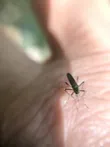
Harmful Effects of Aedes hendersoni
A species of Mosquito
Aedes hendersoni bites can lead to itching and discomfort in humans, with a tendency to breed near human residences, causing persistent annoyance.
Harmful Facts About Aedes hendersoni
What Type of Pest Is Aedes hendersoni?









AI entomologist in your pocket
Scan QR code to download

